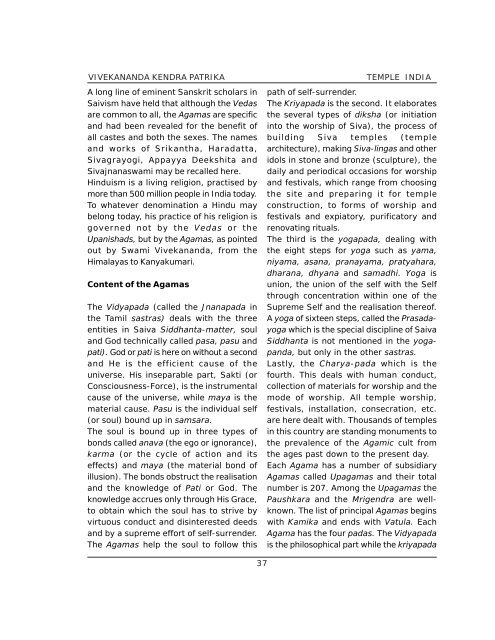Temples In India-1.pdf - Vivekananda Kendra Prakashan
Temples In India-1.pdf - Vivekananda Kendra Prakashan
Temples In India-1.pdf - Vivekananda Kendra Prakashan
Create successful ePaper yourself
Turn your PDF publications into a flip-book with our unique Google optimized e-Paper software.
VIVEKANANDA KENDRA PATRIKAA long line of eminent Sanskrit scholars inSaivism have held that although the Vedasare common to all, the Agamas are specificand had been revealed for the benefit ofall castes and both the sexes. The namesand works of Srikantha, Haradatta,Sivagrayogi, Appayya Deekshita andSivajnanaswami may be recalled here.Hinduism is a living religion, practised bymore than 500 million people in <strong>In</strong>dia today.To whatever denomination a Hindu maybelong today, his practice of his religion isgoverned not by the Vedas or theUpanishads, but by the Agamas, as pointedout by Swami <strong>Vivekananda</strong>, from theHimalayas to Kanyakumari.Content of the AgamasThe Vidyapada (called the Jnanapada inthe Tamil sastras) deals with the threeentities in Saiva Siddhanta-matter, souland God technically called pasa, pasu andpati). God or pati is here on without a secondand He is the efficient cause of theuniverse. His inseparable part, Sakti (orConsciousness-Force), is the instrumentalcause of the universe, while maya is thematerial cause. Pasu is the individual self(or soul) bound up in samsara.The soul is bound up in three types ofbonds called anava (the ego or ignorance),karma (or the cycle of action and itseffects) and maya (the material bond ofillusion). The bonds obstruct the realisationand the knowledge of Pati or God. Theknowledge accrues only through His Grace,to obtain which the soul has to strive byvirtuous conduct and disinterested deedsand by a supreme effort of self-surrender.The Agamas help the soul to follow thisTEMPLE INDIApath of self-surrender.The Kriyapada is the second. It elaboratesthe several types of diksha (or initiationinto the worship of Siva), the process ofbuilding Siva temples (templearchitecture), making Siva-lingas and otheridols in stone and bronze (sculpture), thedaily and periodical occasions for worshipand festivals, which range from choosingthe site and preparing it for templeconstruction, to forms of worship andfestivals and expiatory, purificatory andrenovating rituals.The third is the yogapada, dealing withthe eight steps for yoga such as yama,niyama, asana, pranayama, pratyahara,dharana, dhyana and samadhi. Yoga isunion, the union of the self with the Selfthrough concentration within one of theSupreme Self and the realisation thereof.A yoga of sixteen steps, called the Prasadayogawhich is the special discipline of SaivaSiddhanta is not mentioned in the yogapanda,but only in the other sastras.Lastly, the Charya-pada which is thefourth. This deals with human conduct,collection of materials for worship and themode of worship. All temple worship,festivals, installation, consecration, etc.are here dealt with. Thousands of templesin this country are standing monuments tothe prevalence of the Agamic cult fromthe ages past down to the present day.Each Agama has a number of subsidiaryAgamas called Upagamas and their totalnumber is 207. Among the Upagamas thePaushkara and the Mrigendra are wellknown.The list of principal Agamas beginswith Kamika and ends with Vatula. EachAgama has the four padas. The Vidyapadais the philosophical part while the kriyapada37
















